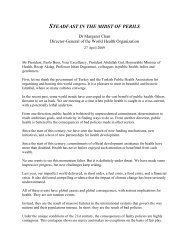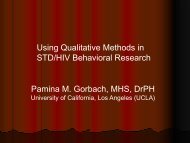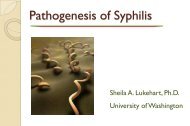The Evolution of HTA in Emerging Markets Health-Care ... - TREE
The Evolution of HTA in Emerging Markets Health-Care ... - TREE
The Evolution of HTA in Emerging Markets Health-Care ... - TREE
You also want an ePaper? Increase the reach of your titles
YUMPU automatically turns print PDFs into web optimized ePapers that Google loves.
OHE Consult<strong>in</strong>g Report for PhRMA<br />
5 January 2011<br />
accord<strong>in</strong>g to economic theory. <strong>The</strong> sellers are, <strong>in</strong> fact, concerned the government has the upper<br />
hand, and that this will push down prices <strong>in</strong> face-‐to-‐face negotiation. Hence, the idea <strong>of</strong><br />
<strong>in</strong>ternational reference pric<strong>in</strong>g becomes appeal<strong>in</strong>g, because it also reduces the costs <strong>of</strong> negotiation.<br />
And if <strong>in</strong>ternational prices are related to “value” to the customer based on will<strong>in</strong>gness to pay for<br />
health ga<strong>in</strong> (reflect<strong>in</strong>g also ability to pay, i.e., <strong>in</strong>come levels), then the reference price could roughly<br />
be based on value.<br />
Thus, the reference price used to set the reimbursement level acts a ceil<strong>in</strong>g on what manufacturers<br />
can obta<strong>in</strong> <strong>in</strong> their negotiation with hospitals, cl<strong>in</strong>ics, and other providers. Without knowledge <strong>of</strong><br />
these discounts, it will not be possible to assess the actual cost-‐effectiveness <strong>of</strong> drugs <strong>in</strong> real-‐world<br />
practice. However, once a health care system is operat<strong>in</strong>g <strong>in</strong> a “second-‐best world”, where some<br />
prices different substantially from opportunity costs, economic theory suggests that it will not be<br />
straightforward to determ<strong>in</strong>e optimal prices.<br />
Smaller high-‐<strong>in</strong>come countries like Taiwan have substantial segments <strong>of</strong> well-‐<strong>of</strong>f <strong>in</strong>dividuals who<br />
expect access to the latest <strong>in</strong>novative medic<strong>in</strong>es. If the US Food and Drug Adm<strong>in</strong>istration (FDA) and<br />
the European Medic<strong>in</strong>es Agency (EMA) have approved a drug, there is usually little reason to<br />
question access or spend substantial resources re-‐review<strong>in</strong>g it. Basically, the Taiwanese government<br />
and NHI will provide access, but try to balance cost conta<strong>in</strong>ment and access <strong>in</strong> order to ma<strong>in</strong>ta<strong>in</strong><br />
citizen support.<br />
Similarly, if the price is <strong>in</strong> alignment with similar countries, the government will have limited need to<br />
do a formal or very sophisticated <strong>HTA</strong> analysis. “Free-‐rid<strong>in</strong>g” or “piggy-‐back<strong>in</strong>g” on other, similar<br />
countries’ assessments is the efficient and logical th<strong>in</strong>g to do. Furthermore, when price is<br />
established by negotiation rather than by rule and transparency, then there is a greater potential for<br />
side deals and corruption. Nonetheless, if the <strong>in</strong>ternational reference prices were too low (i.e.,<br />
suboptimal) to support global R&D efforts, then the result would be dynamically <strong>in</strong>efficient (<strong>in</strong> the<br />
long run for all countries).<br />
On the other hand, the lack <strong>of</strong> a tight l<strong>in</strong>kage between the government-‐established reimbursement<br />
level for new drugs and the acquisition cost (i.e., what manufacturers receive) means that Taiwan’s<br />
contribution to global R&D will be less than would be expected from the reference price. In a recent<br />
review <strong>of</strong> four European nations, Drummond, et al. (2010) reach a conclusion <strong>of</strong> potential relevance<br />
to Taiwan.<br />
Compared with <strong>HTA</strong>, reference pric<strong>in</strong>g is a relatively blunt <strong>in</strong>strument for obta<strong>in</strong><strong>in</strong>g value for money<br />
from pharmaceuticals. Thus, its role <strong>in</strong> mak<strong>in</strong>g reimbursement decisions should be limited to drugs<br />
which are therapeutically equivalent. <strong>HTA</strong> is a superior strategy for obta<strong>in</strong><strong>in</strong>g value for money<br />
because it addresses not only price but also the appropriate <strong>in</strong>dications for the use <strong>of</strong> the drug and<br />
the relation between additional value and additional costs. However, given the relatively higher<br />
costs <strong>of</strong> conduct<strong>in</strong>g <strong>HTA</strong>s, the most efficient approach might be a comb<strong>in</strong>ation <strong>of</strong> both policies.<br />
104








